
Page 1
1.
Bolivia's government attempted to solve some of its problems with inequality of
outcomes due to foreign investment in its natural gas resources by:
A)
taxing international firms.
B)
insisting that the firms pay higher wages to workers in the industry.
C)
shutting down the firms in the wake of protests.
D)
nationalizing the natural gas industry.
2.
The argument that trade generates gains for all workers may NOT be true because:
A)
a more realistic assumption includes capital and land as specific factors of
production and recognizes that trade will generate gains for some factors and losses
for others.
B)
greedy corporations exploit workers.
C)
technology gains are concentrated among low-skilled workers.
D)
some workers lack skills and training and cannot find jobs.
3.
Under free trade and comparative advantage, the home country:
A)
will see only benefits for its resources.
B)
will see only losses for its resources.
C)
will see winners and losers within its economy.
D)
will be convinced that trade is not beneficial.
4.
In the two-sector (manufacturing and agriculture) specific-factors model, which
resource(s) is(are) transferable between sectors?
A)
land
B)
labor
C)
capital
D)
labor and capital
5.
In contrast to the Ricardian model, international trade in the two-sector (manufacturing
and agriculture) specific-factors model:
A)
will lead to gains for all resources.
B)
will lead to losses for all resources.
C)
will lead to gains for some resources and losses for other resources.
D)
will not lead to any in the returns of any resources.

Page 2
6.
The two-sector (manufacturing and agriculture) specific-factors model is termed a
“short-run” model because:
A)
labor cannot move from one activity to another.
B)
land resources can move from one activity to another.
C)
labor can move from one activity to another.
D)
land and capital cannot move from one activity to another.
7.
Which short-run model is used to study the earnings of resources?
A)
comparative advantage theory
B)
absolute advantage theory
C)
specific-factors model
D)
production possibility frontier
8.
A “specific” factor of production is:
A)
critical to the production of the good or service.
B)
not transferable to other types of production and can only be used for the product in
question.
C)
a set quantity for each unit produced.
D)
the opposite of a general factor, meaning it must fit within certain narrow quality
parameters.
9.
In a two-sector (manufacturing and agriculture) specific-factors model:
A)
land, labor, and capital are transferable between sectors.
B)
labor is transferable between sectors.
C)
land is transferable between sectors.
D)
capital is transferable between sectors.
10.
In a two-sector (manufacturing and agriculture) specific-factors model:
A)
land is specific to the manufacturing sector.
B)
labor is specific to the manufacturing sector.
C)
capital is specific to the manufacturing sector.
D)
labor and capital are specific to the manufacturing sector.
11.
In a two-sector (manufacturing and agriculture) specific-factors model, which resource
is specific to the agriculture sector?
A)
labor
B)
land
C)
capital
D)
entrepreneurs

Page 3
12.
What does the two-sector (agriculture and manufacturing) specific-factors model allow
us to analyze?
A)
the returns to all factors of production
B)
only the returns to capital in agriculture
C)
only the returns to land in manufacturing
D)
only the allocation of land to agriculture
13.
In the two-sector (manufacturing and agriculture) specific-factors model, it is assumed
that labor:
A)
can move freely between the manufacturing and agricultural sectors.
B)
can move from the manufacturing to the agriculture sector, but not from the
agricultural to the manufacturing sector.
C)
cannot move from one sector to the other.
D)
cannot move within a sector.
14.
Because of the “law of diminishing marginal returns” to a factor, as more labor is
employed, its marginal product:
A)
rises.
B)
falls.
C)
stays constant.
D)
rises disproportionally.
15.
When there are diminishing marginal returns to factors of production, the PPF is:
A)
a negatively sloped straight line.
B)
bowed out from the origin.
C)
caved in toward the origin.
D)
a positively sloped straight line.
16.
The two-sector (manufacturing and agriculture) specific-factors model assumes:
A)
that there are increasing returns to labor.
B)
that there are diminishing returns to labor.
C)
that there are diminishing returns to capital in the agricultural sector.
D)
that there are diminishing returns to land in the manufacturing sector.

Page 4
17.
Diminishing returns to labor means:
A)
that the marginal product of labor declines as the amount of labor used in a sector
increases.
B)
that the marginal product of labor declines as the amount of capital combined with
labor in a sector increases.
C)
that the marginal product of labor declines as the amount of land combined with
labor in a sector increases.
D)
that the marginal product of capital declines as the amount of labor used in a sector
increases.
18.
In the two-sector specific-factors model, diminishing returns to labor implies:
A)
that the country's production possibilities frontier is linear (a straight line).
B)
that the country's production possibilities frontier is concave to the origin (bowed
out from the origin).
C)
that the country's production possibilities frontier is convex from the origin (bowed
in toward the origin).
D)
that the country's production possibilities frontier may be either concave to or
convex from the origin.
19.
In the two-sector specific-factors model, as more labor is added to a sector, we will see:
A)
the total product of labor decrease.
B)
the marginal product of labor increase.
C)
the average product of labor remains constant.
D)
the marginal product of labor decrease.
20.
If we assume only one factor (labor), we can demonstrate on the PPF the opportunity
cost of producing less of one good and more of the other good by:
A)
taking the sum of the marginal products of labor for the two goods.
B)
taking the difference of the marginal products of labor for the two goods.
C)
taking the ratio of the marginal products of labor for the two goods.
D)
taking the average of the marginal products of labor for the two goods.
21.
When there are diminishing returns to labor, the production possibility frontier is
_______ sloping and ________.
A)
downward; convex (bowed in toward the origin)
B)
downward; concave (bowed out from the origin)
C)
upward; concave (bowed out from the origin)
D)
upward; convex (bowed in toward the origin)

Page 5
22.
In an economy in which labor is mobile and homogeneous, the wages between
industries will be:
A)
equal.
B)
very unequal.
C)
less in the export industry.
D)
unequal because in some firms the management is fairer to its workers.
23.
Consider the following information for a hypothetical economy: If the price per bicycle
is $20 and the wage per worker is $40, then what is the marginal product of labor?
A)
20 bicycles
B)
2 bicycles
C)
0.5 bicycle
D)
1 bicycle
24.
Suppose that the wage is $20 per hour in a two-sector (manufacturing and agriculture)
specific-factors model. Currently, the prices of manufactured and agricultural outputs
are $5 and $1, respectively; the marginal product of labor in the manufactured sector is
6 units per hour; and the marginal product of labor in the agricultural sector is 10 units
per hour. What will happen to the distribution of labor between the two sectors?
A)
Nothing will happen. The current allocation of labor between the two sectors is
ideal.
B)
The manufacturing sector will demand more labor, and the agricultural sector will
demand less labor at the current wage.
C)
The agricultural sector will demand more labor, and the manufacturing sector will
demand less labor at the current wage.
D)
Both the agricultural and the manufacturing sector will demand more labor at the
current wage.
25.
Suppose that wages in the agricultural and manufacturing sectors are $10 and $20 per
hour, respectively, and that the prices of both the agricultural and manufactured good
are both $50 per unit. What is the marginal productivity of labor in the manufacturing
sector?
A)
$1,000
B)
0.4 units per hour
C)
2.5 units per hour
D)
$0.40

Page 6
26.
If the price per bushel of wheat is $3 and the marginal product of labor is four bushels
per hour, then what is the hourly wage?
A)
$0.75
B)
$1.33
C)
$12
D)
four bushels
27.
A microeconomic analysis shows that in a competitive economy in which labor is
homogenous and mobile, the ratio of the prices of the products in equilibrium is
inversely proportional to:
A)
the ratio of the capital used in production.
B)
the ratio of the marginal products of labor.
C)
the geographical region of the country in which the factory is located.
D)
the strength of bargaining power of the workers.
28.
In equilibrium, with diminishing marginal products, the slope of the PPF is equal to:
A)
the ratio of prices for the products.
B)
the marginal product of labor.
C)
the marginal product of capital.
D)
the ratio of prices to the marginal product of labor.
29.
In the two-sector (manufacturing and agriculture) specific-factors model, the slope of
the production possibilities curve equals:
A)
the ratio of marginal products of capital in the two sectors.
B)
the ratio of marginal products of labor utilized in the two sectors.
C)
the ratio of outputs produced in the two sectors.
D)
the ratio of land and capital utilized in the two sectors.
30.
If a nation begins to trade, it will be able to sell (export) the product for which its own
relative price is:
A)
lower than other nations.
B)
higher than other nations.
C)
the same as other nations.
D)
less than 10% of the value of other nations.
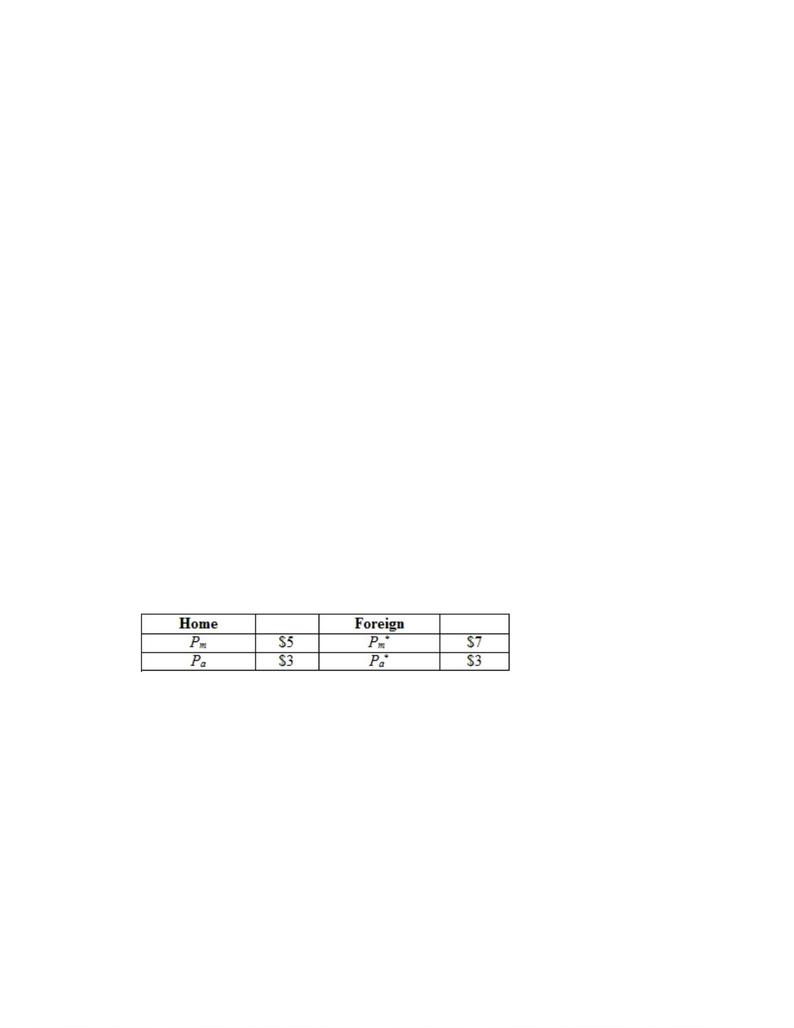
Page 7
31.
If a nation begins to trade, it will wish to buy (import) the product for which its own
relative price is:
A)
lower than other nations.
B)
higher than other nations.
C)
the same as other nations.
D)
less than 10% of the value of other nations.
32.
Suppose that a country has a comparative advantage in agricultural products. When
trade occurs, the nominal and real prices of the agricultural good will:
A)
both fall.
B)
both rise.
C)
both remain constant.
D)
The nominal price will fall and the real price will rise.
33.
Suppose that the home country in the two-sector (manufacturing and agriculture)
specific-factors model has a comparative advantage in manufacturing output. What will
happen to the relative price of manufactured output when trade occurs?
A)
It will fall.
B)
It will rise.
C)
It will not change.
D)
It will first rise, then fall.
34.
(Table: Home and Foreign Prices for Manufacturing and Agriculture) Consider the
information provided about the price of agriculture and manufacturing goods in two
countries (Home and Foreign). Under the condition of no trade, what is the relative price
of manufacturing goods?
A)
1.66 of the agricultural good in Home
B)
0.40 of the agricultural good in Foreign
C)
0.60 of the agricultural good in Home
D)
0.40 of the agricultural good in Foreign and 0.60 of the agricultural good in Home
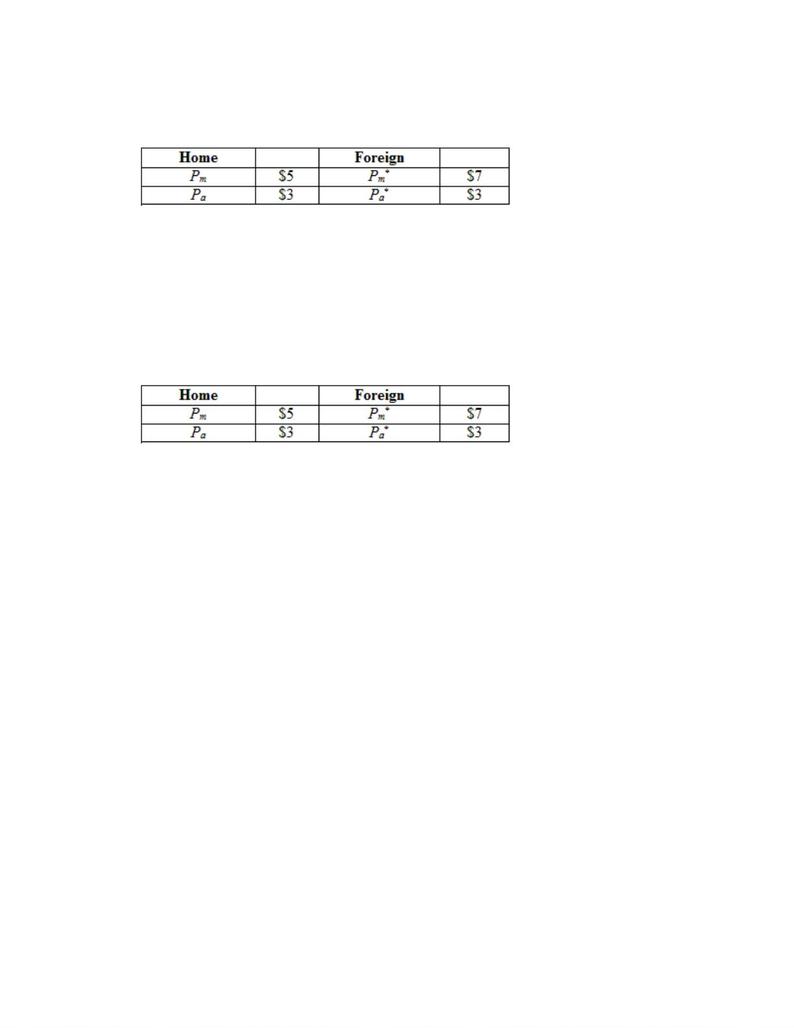
Page 8
35.
(Table: Home and Foreign Prices for Manufacturing and Agriculture) Consider the
information provided about the price of agriculture and manufacturing goods in two
countries (Home and Foreign). If the two countries open their markets for trade, then:
A)
Home has the comparative advantage in agriculture.
B)
Home has the comparative advantage in manufacturing.
C)
Foreign has absolute advantage in both goods.
D)
Foreign has a comparative advantage in manufacturing.
36.
(Table: Home and Foreign Prices for Manufacturing and Agriculture) Consider the
information provided about the price of agriculture and manufacturing goods in two
countries (Home and Foreign). Under free trade conditions, Foreign will export
________ goods and Home will export ___________ goods.
A)
manufactured; agricultural
B)
manufactured; manufactured
C)
agricultural; manufactured
D)
agricultural, agricultural
37.
As a nation begins to export, its own relative price of exported goods will ______, and
as it imports other goods, the relative price of those will ______ , thus ___________ its
standard of living.
A)
fall; rise; lowering
B)
rise; fall; lowering
C)
rise; fall; raising
D)
fall; rise; raising
38.
Which term below describes a situation in which a nation engages in no trade and
produces everything it consumes?
A)
anarchy
B)
oligarchy
C)
autarky
D)
embargo

Page 9
39.
Which term below describes a situation in which a nation prohibits trade with one or
more trading partner nations?
A)
anarchy
B)
oligarchy
C)
autarky
D)
embargo
40.
As a nation opens up to free trade:
A)
the relative prices of the traded products do not change.
B)
the absolute prices measured in the domestic currency do not change.
C)
the relative price rises in the export sector and falls in the import sector.
D)
the export sector experiences a decline in demand.
41.
As a nation opens trade, the relative prices of products it imports will __________ and
the relative prices of products it exports will ___________.
A)
rise; fall
B)
fall; rise
C)
remain constant; fall
D)
rise; remain constant
42.
As a nation increases its production of exports, demand for all factors of production
used in the exporting sector will:
A)
rise.
B)
fall.
C)
remain the same.
D)
decrease but only slightly.
43.
As a nation increases its production of exports, demand for specific or fixed factors
(such as capital and land) used in the exporting sector will:
A)
rise.
B)
fall.
C)
remain the same.
D)
decrease but only slightly.
44.
The absence of trade is known as:
A)
aristocracy.
B)
oligarchy.
C)
autarky.
D)
embargo.

Page 10
45.
From 1807 to 1809, a trade embargo imposed by the United States resulted in:
A)
a rise in real GDP, as residents turned toward domestic production.
B)
a fall in real GDP of about 5%.
C)
a lower unemployment rate in the United States.
D)
a rise in the U.S. standard of living from lower prices as a result of lowered
demand.
46.
When Japan opened its borders to trade with the United States in 1854:
A)
the prices of Japanese exports to the United States rose.
B)
the terms of trade for Japan deteriorated.
C)
there were no gains from trade for the United States.
D)
the prices of Japanese imports from the United States rose.
47.
Many examples in this chapter indicate that there are substantial __________ as a result
of competition and trade.
A)
environmental disasters
B)
labor shortages and strikes
C)
gains to the economy
D)
losses to consumers and workers
48.
In a competitive market, what happens to the equilibrium wage?
A)
It differs among industries.
B)
It is equal to the marginal product of the labor..
C)
It is determined by the intersection of curves representing the demand for and the
supply of imports.
D)
It is the same in all industries.
49.
Suppose that the home country in the two-sector (manufacturing and agriculture)
specific-factors model has a comparative advantage in agricultural output. Will workers
be better or worse off following the opening of trade with other countries?
A)
Workers will be better off because the nominal wage increases.
B)
Workers will be worse off because the nominal wage decreases.
C)
Workers may be better off or worse off because the real wage in terms of the
agricultural good rises and the real wage in terms of the manufactured good falls.
D)
Workers may be better off or worse off because the real wage in terms of the
agricultural good falls and the real wage in terms of the manufactured good rises.

Page 11
50.
If the wage rate in the agriculture sector is lower than the manufacturing sector, then
labor will migrate to the manufacturing sector. This will cause:
A)
both the wage and the marginal product of labor in the manufacturing sector to
decrease.
B)
both the wage and the marginal product of labor in the agriculture sector to
decrease.
C)
the nation to import more goods.
D)
There will be no effect on either sector.
51.
The term real wages refers to:
A)
a worker's hourly wage in dollars.
B)
the purchasing power of a worker's wage.
C)
the productivity of a worker's labor.
D)
the productivity of a worker's capital.
52.
A change in the relative price of one good versus another will cause a change in
marginal product and the allocation of labor resources. When the price of good A
increases relative to the price of good B and labor is mobile, the equilibrium real wage
in industry A will:
A)
rise in terms of good B.
B)
fall in terms of good B.
C)
remain the same.
D)
rise in terms of good A.
53.
As relative prices in various industries change due to trade, the marginal product of the
mobile resources used in the expanding industry __________, and the marginal product
of the mobile resources used in the contracting industry __________.
A)
rises; falls
B)
falls; rises
C)
remains the same; remains the same
D)
changes by exactly the same percentage; changes by exactly the same percentage
54.
As relative prices in various industries change due to trade, the marginal product of
fixed resources used in the expanding industry __________, and the marginal product of
fixed resources used in the contracting industry __________.
A)
rises; falls
B)
remains the same; remains the same
C)
changes by exactly the same percentage; changes by exactly the same percentage
D)
falls; rises

Page 12
55.
If the relative price of one product rises and labor is mobile, then:
A)
the percentage increase in the equilibrium real wage will be exactly the same as the
percentage increase in the relative price.
B)
the percentage increase in the equilibrium real wage will be lower than the
percentage increase in the relative price.
C)
the percentage increase in the equilibrium real wage will be higher than the
percentage increase in the relative price.
D)
the equilibrium real wage will not change.
56.
In the two-sector (manufacturing and agriculture) specific-factors model, an increase in
the price of the manufactured good will cause:
A)
an increase in the wage in the manufacturing sector.
B)
capital to move from the agricultural to the manufacturing sector.
C)
land to move from the manufacturing to the agricultural sector.
D)
a decrease in the wage in the agricultural sector.
57.
An increase in demand for resources specific to an industry will cause their earnings to
_____ because those resources cannot be released from other industries.
A)
fall
B)
rise by the same rate as for all resources
C)
rise disproportionally
D)
fall disproportionally
58.
When the demand for products competing with imports falls, demand for the specific
factors used in their production falls and:
A)
the relative prices (earnings) of these specific factors will fall disproportionally.
B)
the relative prices (earnings) of these specific factors will rise disproportionally.
C)
the relative prices (earnings) of these specific factors will fall by the same rate as
for all resources.
D)
the employment of these specific factors will rise disproportionally.
59.
In the two-sector (manufacturing and agriculture) specific-factors model, suppose that a
country has a comparative advantage in manufacturing output. Will workers be better or
worse off following the opening of trade with other countries?
A)
Workers will be better off because the nominal wage increases.
B)
Workers will be better off because both nominal and real wages increase.
C)
Workers may be better off or worse off because the real wage in terms of the
agricultural good rises and the real wage in terms of the manufactured good falls.
D)
Workers may be better off or worse off because the real wage in terms of the
agricultural good falls and the real wage in terms of the manufactured good rises.
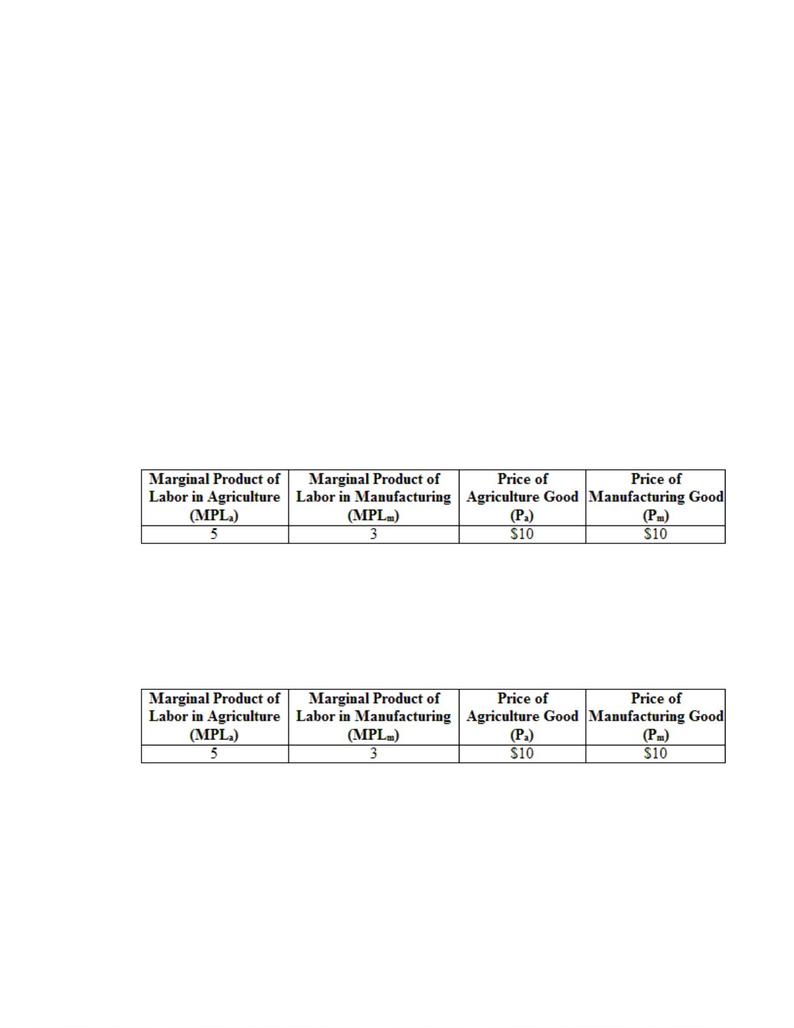
Page 13
60.
In the two-sector (manufacturing and agriculture) specific-factors model, an increase in
the price of the manufactured good will cause:
A)
a decrease in nominal wages in both the agricultural and manufacturing sectors.
B)
an increase in real wages in both the agricultural and manufacturing sectors.
C)
an increase in both nominal and real wages in both the agricultural and
manufacturing sectors.
D)
an increase in nominal wages in both the agricultural and manufacturing sectors.
61.
In the two-sector (manufacturing and agriculture) specific-factors model, an increase in
the price of the agricultural good will cause:
A)
a decrease in nominal wages in both the agricultural and manufacturing sectors.
B)
an increase in nominal wages in both the agricultural and manufacturing sectors.
C)
an increase in both nominal and real wages in both the agricultural and
manufacturing sectors.
D)
an increase in the nominal wage in the agricultural sector and a decrease in nominal
wage in the manufacturing sector.
62.
(Table: Production and Prices in Two Industries) According to the information provided
in the table, the wage rate in the agriculture sector is:
A)
$50.
B)
$15.
C)
$30.
D)
$10.
63.
(Table: Production and Prices in Two Industries) According to the information provided
in the table, the wage rate in the manufacturing sector is:
A)
$50.
B)
$10.
C)
$100.
D)
$30.

Page 14
64.
(Table: Production and Prices in Two Industries) Using the information from the table,
we can expect which of the following to happen in the economy?
A)
Labor will migrate from the agriculture to the manufacturing sector.
B)
Labor will migrate from the manufacturing to the agriculture sector.
C)
The marginal product of labor in the agriculture sector will increase.
D)
The marginal product of labor in the manufacturing sector will decrease.
65.
(Table: Production and Prices in Two Industries) According to the information provided
in the table, if the price of the agriculture good decreases to $5, then:
A)
wages in the manufacturing sector will be $25.
B)
the wage rate in the agriculture sector will be $25.
C)
the marginal product of both sectors will decline.
D)
more agriculture goods should be imported.
66.
If we consider the two-sector (manufacturing and agriculture) specific-factors model,
the effect of an increase in exports on the real wages of workers:
A)
is inconclusive because some goods' prices will be higher compared with the wage,
and some will be lower.
B)
absolutely increases the buying power of the real wage.
C)
absolutely decreases the buying power of the real wage.
D)
will encourage foreign workers to emigrate to the United States.
67.
Suppose that the home country in the two-sector (manufacturing and agriculture)
specific-factors model has a comparative advantage in manufactured output. Will
workers be better or worse off following the opening of trade with other countries?
A)
Workers will be better off because the nominal wage increases.
B)
Workers will be worse off because the nominal wage decreases.
C)
Workers may be better off or worse off because the real wage in terms of the
agricultural good rises and the real wage in terms of the manufactured good falls.
D)
Workers may be better off or worse off because the real wage in terms of the
agricultural good falls and the real wage in terms of the manufactured good rises.

Page 15
68.
If trade causes shifts in production so that some workers are laid off, most economists
conclude:
A)
that the nation should extend unemployment benefits for a longer period.
B)
that the situation is usually temporary because there are jobs created in export
industries.
C)
that we should expect wages to fall and therefore should not allow imports to take
U.S. jobs.
D)
that all workers will be better off because overall the equilibrium wage will rise.
69.
Suppose that labor is mobile between sectors but that capital and land are specific. Then
labor is more likely to benefit from trade when:
A)
it spends a large amount of its income on the imported good.
B)
it spends a large amount of its income on the exported good.
C)
wages do not change much in percentage terms.
D)
wages increase only in industries competing with imports.
70.
Economists believe that layoffs and wage declines due to increased imports:
A)
are the most critical problem facing the economy today.
B)
may be caused by factors such as changing technology and changing demands for
workers rather than by increased imports.
C)
should be addressed by the WTO, which usually ignores such issues.
D)
are so minor that we may safely ignore them.
71.
If trade causes some workers to be laid off, most economists conclude that:
A)
all other workers will be better off because their wages will rise.
B)
we should not allow imports to take U.S. jobs.
C)
we should expect wages to fall.
D)
most of the workers laid off will be reemployed.
72.
In an industrialized country, the amount of labor employed in the agriculture sector is:
A)
larger than labor employed in the manufacturing sector.
B)
larger than labor employed in the service sector.
C)
lower than labor employed in either the manufacturing or the service sector.
D)
is about the same as labor employed in the service sector.

Page 16
73.
Which of the following is NOT a possible explanation for wage differences across
sectors?
A)
Demand for products affects demand for resources.
B)
Changes in technology affect demand for resources.
C)
The government mandates a $15 per hour minimum wage for service workers.
D)
Import competition in a sector leads to lower wages.
74.
Which of the following best describes changes in U.S. manufacturing employment
between 1973 and 2014?
A)
Manufacturing employment fell, but manufacturing employment as a share of total
U.S. employment rose.
B)
Manufacturing employment rose, but manufacturing employment as a share of total
U.S. employment fell.
C)
Both manufacturing employment and manufacturing employment as a share of
total U.S. employment fell.
D)
Both manufacturing employment and manufacturing employment as a share of
total U.S. employment rose.
75.
Which statement below is correct?
A)
Between 2011 and 2014, there were more manufacturing workers displaced by
trade than service workers displaced by trade.
B)
Between 2011 and 2014, younger workers displaced by trade had larger losses than
older workers displaced by trade.
C)
Between 2011 and 2014, about 60% of manufacturing and service workers
displaced by trade were reemployed.
D)
Between 2011 and 2014, most service workers displaced by trade were reemployed
in higher paying jobs.
76.
According to the Bureau of Labor Statistics, the people losing jobs in the manufacturing
sector between 2011 and 2014 were:
A)
more likely to find higher paying jobs than service sector workers.
B)
less likely to find higher paying jobs than service sector workers.
C)
more likely to work in a foreign country.
D)
more likely to be reemployed than those in the service sector.
77.
The Trade Adjustment Assistance program is:
A)
an unemployment insurance program regardless of the reason for job loss.
B)
an unemployment insurance program that pays for job loss due to import
competition.
C)
a subsidy program for the producers.
D)
a tax on importers of foreign goods.

Page 17
78.
The United States maintains a program to help workers affected by trade relocation.
This is called:
A)
the North American Free Trade Alliance.
B)
the Worker Retraining and Education Act.
C)
Trade Adjustment Assistance.
D)
Supplemental Security Income (SSI).
79.
Which federal government program provides additional benefits to workers who are laid
off because of import competition?
A)
Trade Unemployment Insurance
B)
Import Unemployment Insurance
C)
Trade Adjustment Assistance
D)
Unemployment Insurance
80.
In the United States, which workers displaced by trade between 2011 and 2014 were
more likely to be reemployed?
A)
those in the service industries
B)
those in the manufacturing industries
C)
Evidence indicates that there is no difference across industries.
D)
There is no available evidence on this topic.
81.
Trade Adjustment Assistance provides:
A)
training to those employed in exporting industries.
B)
training to those employed in import-competing industries.
C)
extra income to those employed in import-competing industries.
D)
extra income to those formerly employed in import-competing industries.
82.
Under the 2009 jobs stimulus bill signed by President Obama, which workers can apply
for aid after losing their jobs because of import competition?
A)
service sector workers
B)
manufacturing sector workers
C)
neither service sector workers nor manufacturing sector workers
D)
both service sector workers and manufacturing sector workers
83.
Some economists believe that an extended safety net for workers affected by trade:
A)
would be extremely expensive and unnecessary.
B)
would create a more favorable attitude toward trade by workers.
C)
would create jealousy among those who lose jobs for other reasons.
D)
would lead to political maneuvering and corruption.

Page 18
84.
In the two-sector (manufacturing and agriculture) specific-factors model, an increase in
the price of manufactured goods will cause a(n):
A)
increase in the real rental of capital.
B)
decrease in the real rental of capital.
C)
change in the real rental of capital.
D)
decrease in the nominal wage in the manufacturing sector.
85.
Suppose that the home country in the two-sector (manufacturing and agriculture)
specific-factors model has a comparative advantage in manufacturing output. What will
happen to the amount of land used in producing agricultural output when trade occurs?
A)
It will fall.
B)
It will rise.
C)
It will not change.
D)
It will first fall, then rise.
86.
Suppose that the home country in the two-sector (manufacturing and agriculture)
specific-factors model has a comparative advantage in manufacturing output. What will
happen to the return (rental) on land when trade occurs?
A)
It will fall.
B)
It will rise.
C)
It will not change.
D)
It will first fall, then rise.
87.
The two-sector (manufacturing and agriculture) specific-factors model assumes that in
each industry there are factors of production that are:
A)
less productive.
B)
outsourced to other nations.
C)
fixed or immobile.
D)
very scarce and therefore have a high supply price.
88.
The specific-factors model concludes that if there is an increase in the relative price (and
an expansion) of one industry, the factor specific to that industry:
A)
will experience an increase in its marginal product.
B)
will experience a decrease in its marginal product.
C)
will be transferred to other industries.
D)
will have competition as additional units of that specific factor are hired from other
industries.

Page 19
89.
Suppose that the home country in the two-sector (manufacturing and agriculture)
specific-factors model has a comparative advantage in manufacturing output. What will
happen to the return (rental) on capital when trade occurs?
A)
It will fall.
B)
It will rise.
C)
It will not change.
D)
It will first fall, then rise.
90.
Suppose that the home country in the two-sector (manufacturing and agriculture)
specific-factors model has a comparative advantage in agricultural output. What will
happen to the return (rental) on capital when trade occurs?
A)
It will fall.
B)
It will rise.
C)
It will not change.
D)
It will first fall, then rise.
91.
Suppose that the home country in the two-sector (manufacturing and agriculture)
specific-factors model has a comparative advantage in manufactured output. What will
happen to the marginal product of capital used in manufacturing production when trade
occurs?
A)
It will fall.
B)
It will rise.
C)
It will not change.
D)
It will first fall, then rise.
92.
Suppose that the home country in the two-sector (manufacturing and agriculture)
specific-factors model has a comparative advantage in manufactured output. What will
happen to the amount of capital used in manufacturing production when trade occurs?
A)
It will fall.
B)
It will rise.
C)
It will not change.
D)
It will first fall, then rise.
93.
Suppose that the home country in the two-sector (manufacturing and agriculture)
specific-factors model has a comparative advantage in agricultural output. What will
happen to the return (rental) on land when trade occurs?
A)
It will fall.
B)
It will rise.
C)
It will not change.
D)
It will first fall, then rise.

Page 20
94.
The specific-factors model concludes that if there is a decrease in the relative price in
(and a contraction of) one industry, the factor specific to that industry:
A)
will experience an increase in its marginal product.
B)
will experience a decrease in its marginal product.
C)
will be transferred to other industries.
D)
will have competition as additional units of that specific factor are hired from other
industries.
95.
In the specific-factors model, suppose that a country has a comparative advantage in
manufacturing output. Will landowners be better or worse off following the opening of
trade with other countries?
A)
They will be better off.
B)
They will be worse off.
C)
They may be better off or worse off because the real rental on capital in terms of
the agricultural good rises and the real rental in terms of the manufactured good
falls.
D)
They may be better off or worse off because the real rental on capital in terms of
the manufactured good rises and the real rental in terms of the agricultural good
falls.
96.
As a general rule, the return to (or rental price of) a specific factor used in a product
tends to:
A)
rise disproportionally when the product is exported.
B)
fall disproportionally when the product is exported.
C)
benefit its owners when there is a decrease in the relative price of the product.
D)
rise disproportionally when the product is imported.
97.
As a general rule, when there are specific factors, owners of factors specific to the
importing industry are ______________, whereas owners of factors specific to export
industries are ______________.
A)
harmed; benefited
B)
benefited; harmed
C)
unemployed; hired
D)
not affected; harmed

Page 21
98.
As a general rule, when there are specific factors, owners of factors specific to the
importing industry are ______________, whereas the mobile factor owners (such as
labor) in that industry are ______________.
A)
harmed; benefited
B)
benefited; harmed
C)
harmed; either benefited or harmed, depending on consumption patterns
D)
not affected; harmed
99.
In the two-sector (manufacturing and agriculture) specific-factors model, suppose that
the home country has a comparative advantage in manufacturing output. Why does the
return to capital change after trade occurs?
A)
There is more labor used per unit of capital in the manufacturing sector.
B)
There is more capital used per unit of labor in the manufacturing sector.
C)
There is more labor used per unit of land in the agricultural sector.
D)
There is more land used per unit of labor in the agricultural sector.
100.
In the two-sector (manufacturing and agriculture) specific-factors model, suppose that
the home country has a comparative advantage in agricultural output. What will happen
to the amount of capital used in manufacturing production when trade occurs?
A)
It will fall.
B)
It will rise.
C)
It will not change.
D)
It will first fall, then rise.
101.
In the two-sector (manufacturing and agriculture) specific-factors model, suppose that
the home country has a comparative advantage in agricultural output. What will happen
to the amount of capital used in agricultural production when trade occurs?
A)
It will fall.
B)
It will rise.
C)
It will not change.
D)
It will first fall, then rise.
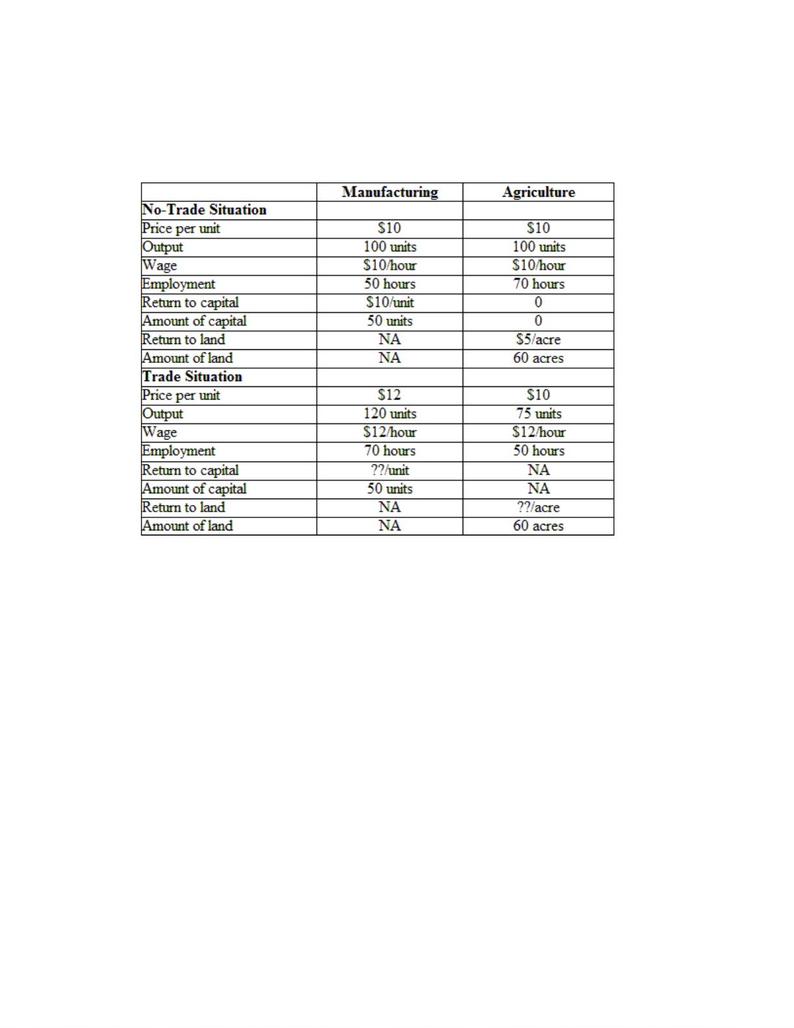
Page 22
102.
(Table: An Economy Before and After Trade) According to the table, what is the return
to capital after trade occurs?
The top part of the table gives manufacturing and agricultural prices, production,
resource utilization, and resource payments in autarky (a no-trade situation). The
bottom part of the table provides (some of) the same information after trade occurs.
A)
$10.00 per unit
B)
$12.00 per unit
C)
$17.60 per unit
D)
$24.00 per unit
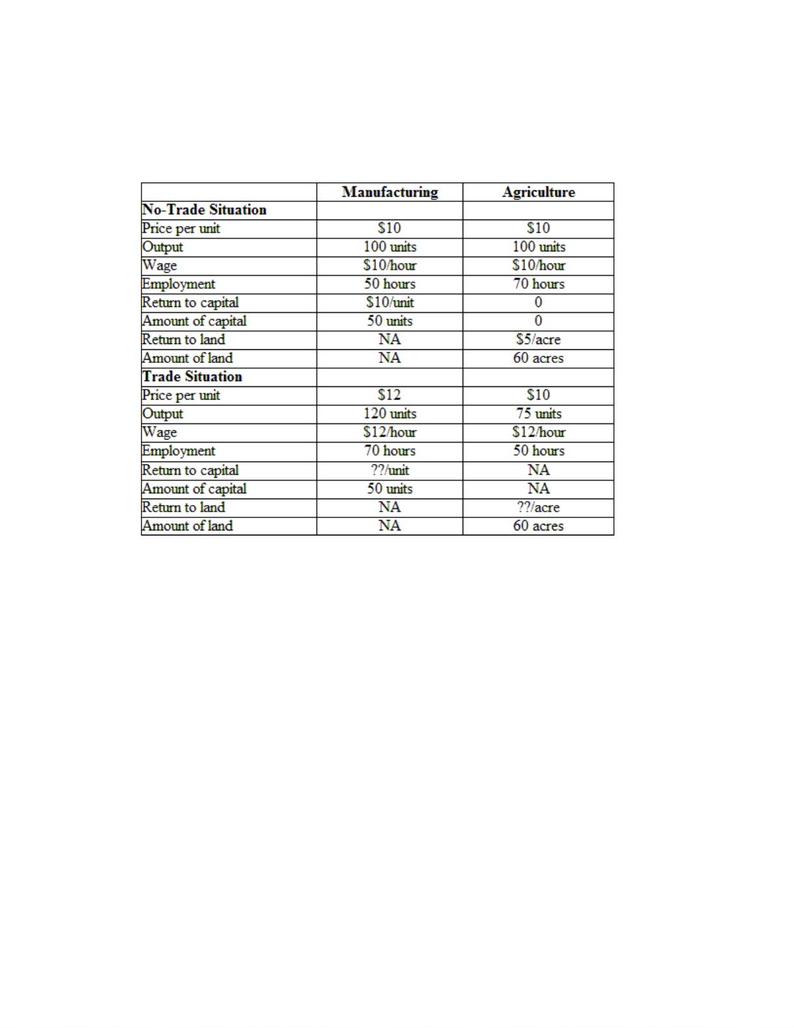
Page 23
103.
(Table: An Economy Before and After Trade) What is the return to land after trade
occurs?
The top part of the table gives manufacturing and agricultural prices, production,
resource utilization, and resource payments in autarky (a no-trade situation). The
bottom part of the table provides (some of) the same information after trade occurs.
A)
$5.00 per acre
B)
$2.50 per acre
C)
$150.00 per acre
D)
$22.00 per acre
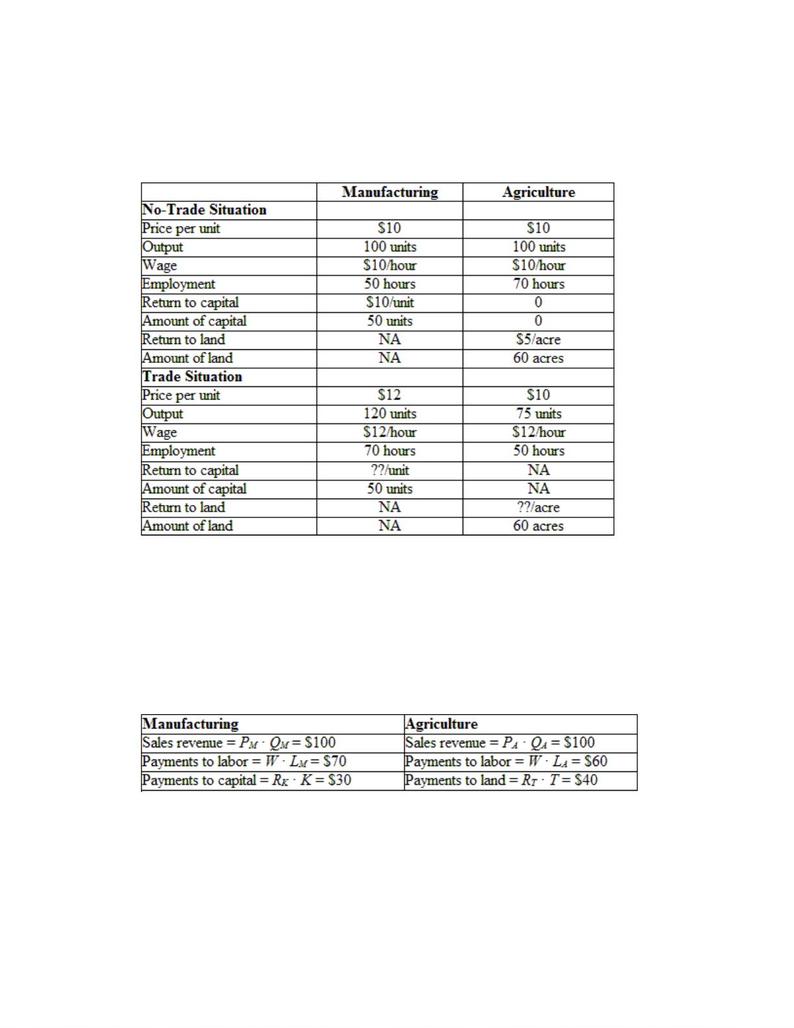
Page 24
104.
(Table: An Economy Before and After Trade) Why does the return to capital change
after trade occurs?
The top part of the table gives manufacturing and agricultural prices, production,
resource utilization, and resource payments in autarky (a no-trade situation). The
bottom part of the table provides (some of) the same information after trade occurs.
A)
There is more labor used in the manufacturing sector.
B)
There is more capital used in the manufacturing sector.
C)
There is more labor used in the agricultural sector.
D)
There is more land used in the agricultural sector.
105.
(Table: Revenues and Costs for Two Industries) Suppose that the table gives payments
to labor, land, and capital in the manufacturing and agriculture sectors. Suppose further
that the price of manufacturing goods increases by 10% (PM), and wages increase by
5%; then the rental rate on capital will:
A)
decrease by 16%.
B)
increase by 21.67%.
C)
remain unchanged.
D)
decrease by 21.67%.
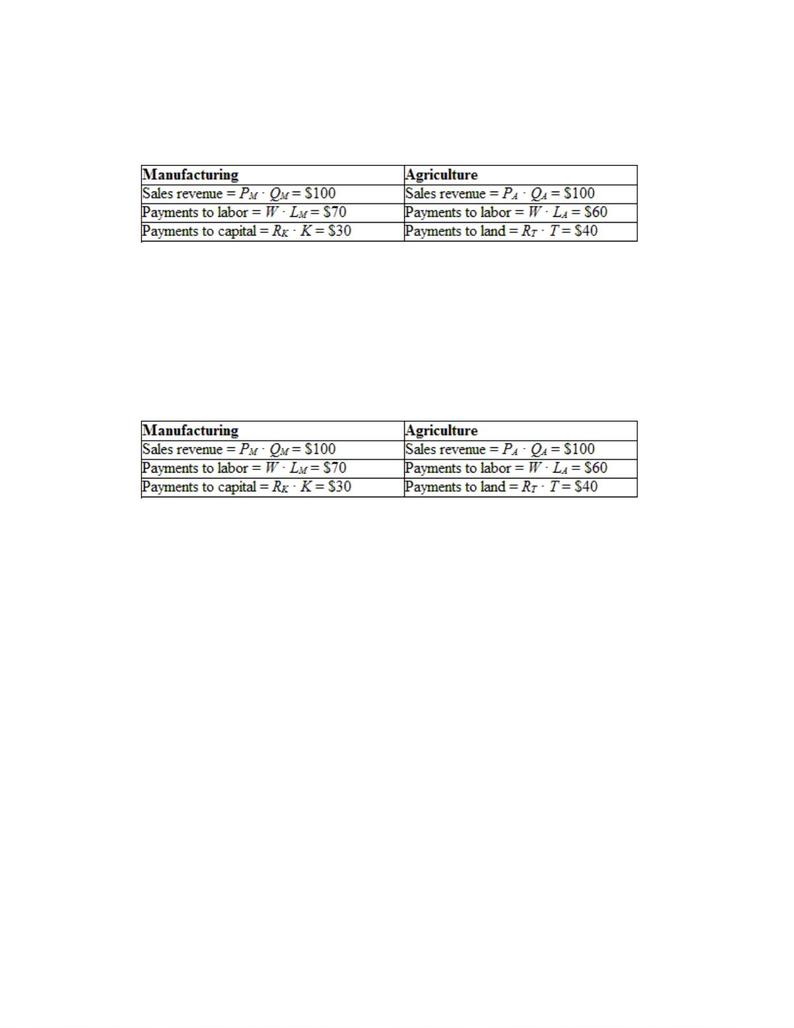
Page 25
106.
(Table: Revenues and Costs for Two Industries) Suppose that the table gives payments
to labor, land, and capital in the manufacturing and agriculture sectors. Now, suppose
that the price of manufacturing goods increases by 10% (PM), and wages increase by
5%; then the rental rate on land will:
A)
increase by 7.5%.
B)
decrease by 5%.
C)
decrease by 7.5%.
D)
not change.
107.
(Table: Revenues and Costs for Two Industries) Suppose that the table gives payments
to labor, land, and capital in the manufacturing and agriculture sectors. Now, suppose
that the price of manufacturing goods increases by 10% (PM), and wages increase by
5%. What would we expect to take place?
A)
More output will be produced in the agriculture sector.
B)
Labor will migrate to the agriculture sector.
C)
More output will be produced in the manufacturing sector.
D)
The rental rate on capital will decline.
108.
Suppose that the home country in the two-sector (manufacturing and agriculture)
specific-factors model has a comparative advantage in manufactured output. What is the
effect on the return of capital after trade occurs?
A)
The return on capital increases.
B)
The return on capital decreases.
C)
The return on capital does not change.
D)
The effect cannot be determined.
109.
Suppose that the home country in the two-sector (manufacturing and agriculture)
specific-factors model has a comparative advantage in manufactured output. Which
statement below best describes changes in returns on capital and land after trade occurs?
A)
The return on capital and land will both rise.
B)
The return on capital and land will both fall.
C)
The return on capital will rise and the return on land will fall.
D)
The return on capital will fall and the return on land will rise.

Page 26
110.
Suppose that the home country in the two-sector (manufacturing and agriculture)
specific-factors model has a comparative advantage in manufactured output. What is the
change to the return on land after trade occurs?
A)
The return on land increases.
B)
The return on land decreases.
C)
The return on land does not change.
D)
The effect cannot be determined.
111.
Suppose that the home country in the two-sector (manufacturing and agriculture)
specific-factors model has a comparative advantage in manufactured output. After trade
occurs, the return on capital will ____________ the price of the manufactured good.
A)
increase faster than
B)
increase slower than
C)
increase at the same rate as
D)
decrease faster than
112.
Suppose that the home country in the two-sector (manufacturing and agriculture)
specific-factors model has a comparative advantage in manufactured output. Which
specific factor will gain after trade occurs?
A)
capital
B)
land
C)
both capital and land
D)
labor
113.
Which of the following statements about the specific-factors model is true?
A)
When exports of a product rise, the increase in export revenue is divided equally
among mobile and specific factors of production.
B)
When imports rise, revenues of firms that compete with imports fall. The decrease
in revenue is divided equally among the mobile and specific factors of production.
C)
When exports of a product rise, factors specific to exports gain less than mobile
factors; when imports rise, factors specific to import competing industries gain
more than mobile factors.
D)
When exports of a product rise, factors specific to exports gain more than mobile
factors; when imports rise, factors specific to import competing industries lose
more than mobile factors.
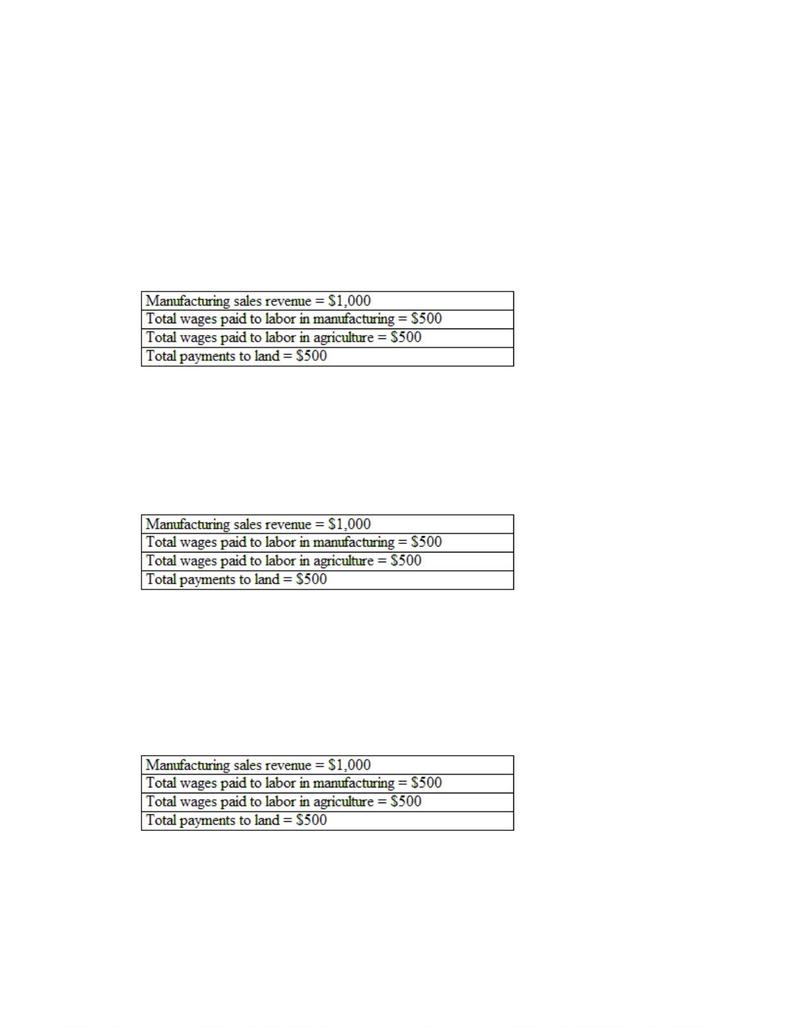
Page 27
114.
Suppose that the home country in the two-sector (manufacturing and agriculture)
specific-factors model has a comparative advantage in manufactured output. Which
specific factor(s) will gain the most after trade occurs?
A)
capital
B)
land
C)
labor
D)
land and capital
115.
(Table: Sales and Payments) What is the total payment to capital in the manufacturing
sector?
A)
$1,500
B)
$1,000
C)
$500
D)
$0
116.
(Table: Sales and Payments) What is the total revenue (Price · Quantity) of the
agricultural sector?
A)
$400
B)
$500
C)
$600
D)
$1,000
117.
(Table: Sales and Payments) Suppose that the price of the manufactured good rises by
20% with no change in the price of the agricultural good. Wages in both sectors rise by
10%. What is the new value of the payment to capital?
A)
$700
B)
$650
C)
$600
D)
$500
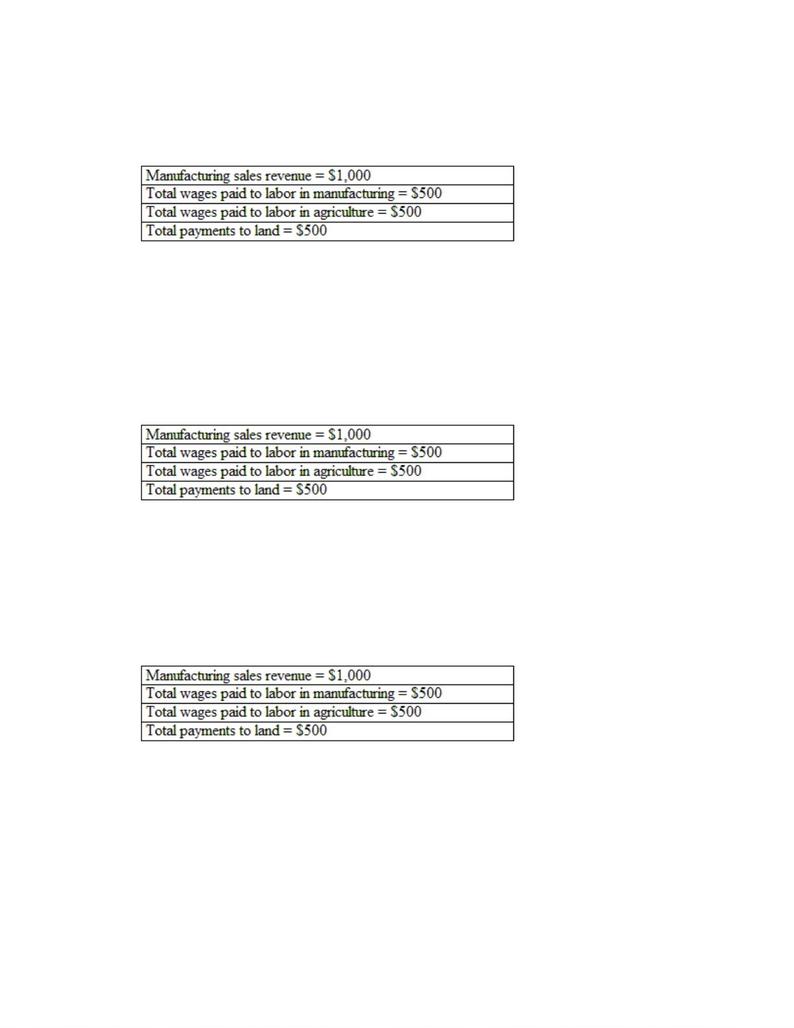
Page 28
118.
(Table: Sales and Payments) Suppose that the price of the manufactured good rises by
20% with no change in the price of the agricultural good. Wages in both sectors rise by
10%. What is the new value of the rental on land?
A)
$550
B)
$500
C)
$450
D)
$400
119.
(Table: Sales and Payments) Suppose that the price of the manufactured good rises by
20% with no change in the price of the agricultural good. Wages in both sectors rise by
10%. Which of the following is the correct ordering (from highest to lowest) of changes
in the real wage, real rental on capital, and real rental on land?
A)
real rental on land, real wage, real rental on capital
B)
real wage, real rental on land, real rental on capital
C)
real rental on capital, real rental on land, real wage
D)
real rental on capital, real wage, real rental on land
120.
(Table: Sales and Payments) Suppose that the price of the agricultural good increases
with no change in the price of the manufactured good. Which of the following resources
will show the most gain?
A)
capital
B)
labor
C)
land
D)
capital and labor

Page 29
121.
Which specific factor loses from trade?
A)
one that is specific to the importing industry
B)
one that is specific to the exporting industry
C)
one that is mobile between sectors
D)
None of these loses from trade.
122.
Suppose a government wants to raise money to compensate the losers from trade. In a
specific-factors model, the government could tax:
A)
the factor specific to the importing industry.
B)
the factor specific to the exporting industry.
C)
the factor that is mobile between industries.
D)
all citizens equally.
123.
Suppose that land is specific to agriculture, capital is specific to manufacturing, and
labor is mobile between sectors. According to the specific-factors model, if this country
begins importing manufactured goods, which factor will experience the highest
unemployment?
A)
labor
B)
capital
C)
land
D)
No factors will experience unemployment.
124.
One reason that nations impose agricultural quotas and other restrictions is:
A)
to limit imports to protect the incomes of specific factors (farm owners).
B)
to ensure a plentiful food supply.
C)
to keep the food supply safe from harmful additives used in foreign nations.
D)
to lower wages.
125.
The example of fair-trade coffee illustrates the problem of trying to stabilize returns to
specific factors. What is the problem?
A)
Production is inherently egalitarian—all resources get the same return.
B)
When world coffee prices rise farmers of fair-trade coffee may receive a lower
price than that offered on the world market.
C)
When coffee prices fall, the farmers will sell their plots and seek employment in
other industries.
D)
Fair-trade efforts are unpopular among U.S. workers, who see imports increase and
their returns from coffee production fall.

Page 30
126.
What is the idea behind fair-trade coffee?
A)
ensuring a minimum price for middlemen
B)
ensuring a maximum price for consumers
C)
ensuring a minimum price for the producers
D)
ensuring a minimum price for the consumers
127.
Coffee prices fell in the 1990s because of:
A)
subsidies by developed countries to their coffee producers.
B)
subsidies by developing countries to their coffee producers.
C)
new suppliers in Brazil and Vietnam.
D)
a fall in world demand for coffee.
128.
In what way does the specific-factors model add to the conclusions of the Ricardian
model?
A)
In the Ricardian model, only labor is better off with free trade. In the
specific-factors model, all resources (labor, land, and capital) are better off with
free trade.
B)
In the Ricardian model, a country is better off with free trade. In the
specific-factors model, some of a country's resources will be worse off with free
trade.
C)
In the Ricardian model, some of a country's resources will be worse off with free
trade. In the specific-factors model, some of a country's resources will be better off
with free trade.
D)
In the Ricardian model, labor will be worse off with free trade. In the
specific-factors model, labor will be better off with free trade.
129.
In general, the gains to some resources from free trade exceed losses suffered by other
resources. This means that, in principle:
A)
the government should be able to tax resources that gain and compensate resources
that lose, so all resources are better off with trade.
B)
the government should tax imports in order to reduce the losses suffered by some
resources.
C)
the government ought to tax exports in order to collect revenue to compensate
resources that lose from free trade.
D)
the government ought to tax returns on land because these always increase with
free trade.

Page 31
130.
Suppose that due to a drought, the price of agricultural goods rises by 10%. If land is
specific to agriculture, capital is specific to manufacturing, and labor is mobile between
sectors, which of the following is true?
A)
The percentage change in labor income is less than zero.
B)
The percentage change in labor income is greater than 10%.
C)
The percentage change in returns to capital is greater than 10%.
D)
The percentage change in labor income is less than 10%.
131.
Suppose that world demand shifts away from agricultural goods toward high-tech
manufactured goods. If land is specific to agriculture, capital is specific to
manufacturing, and labor is mobile between sectors, which of the following is true?
A)
The percentage increase in capital income is less than the percentage increase in
labor income.
B)
The percentage increase in labor income is more than the percentage increase in the
relative price of manufacturing goods.
C)
The percentage change in capital income is greater than zero.
D)
The percentage increase in returns to land is more than the percentage increase in
the relative price of manufacturing goods.
132.
Why do returns to specific factors change by more than returns to mobile factors when
international trade changes relative prices?
133.
Suppose that the wage is $20 per hour in a two-sector (manufacturing and agriculture)
specific-factors model. Currently, the prices of manufactured and agricultural outputs
are $5 and $1, respectively; the marginal product of labor in the manufactured sector is
six units per hour; and the marginal product of labor in the agricultural sector is 10 units
per hour. What will happen to the distribution of labor between the two sectors?
134.
Suppose that the wage is $20 per hour in a two-sector (manufacturing and agriculture)
specific-factors model. Currently, the prices of manufactured and agricultural outputs
are $5 and $1, respectively; the marginal product of labor in the manufactured sector is
six units per hour; and the marginal product of labor in the agricultural sector is 10 units
per hour. What will happen to the rentals on land and capital?
135.
Suppose that wages in the agricultural and manufacturing sectors are $10 and $20 per
hour, respectively, and that the prices of both the agricultural and manufactured good
are both $50 per unit. What are the marginal productivities of labor in the agricultural
and manufacturing sectors?

Page 32
136.
According to the two-sector (manufacturing and agriculture) specific-factor model, will
nominal and real wages rise, fall, or not change when a country with a comparative
advantage in agricultural output moves from an autarkic to a free trade situation?
137.
Suppose that capital is mobile between sectors but that there are two kinds of specific
labor: skilled and unskilled. If skilled labor prefers autarky to free trade, what can you
say about the number of skilled workers relative to the number of unskilled workers?
138.
What U.S. program compensates workers for losses experienced as a result of trade?
139.
Describe changes in the share of manufacturing employment in total employment and in
manufacturing wages over the past 40 years.
140.
Why must we know the composition of consumption in an economy in order to judge
the effects of international trade on real income of the mobile factor?
141.
According to the two-sector (manufacturing and agriculture) specific-factor model, will
returns to capital and land rise, fall, or not change when a country with a comparative
advantage in agricultural output moves from an autarkic to a free trade situation?
142.
Suppose that land is specific to corn, capital is specific to automobiles, labor is mobile
between sectors, and payments are as follows:
Automobiles: Sales revenue = 200; payments to labor = 100; payments to capital = 100
Corn: Sales revenue = 100; payments to labor = 40; payments to land = 60
Holding the price of automobiles constant, suppose the increase in the price of corn is
20% and the increase in the wage is 10%. What is the impact of this on the income of
land and the income of capital? What has happened to the real income of land? What
has happened to the real income of capital? What has happened to the real income of
labor?
143.
Suppose that you are trying to decide between being a factor that is mobile between
sectors and one that is specific to a particular sector. What are the relative benefits and
costs to becoming specific?

Page 33
144.
Suppose that land is specific to agriculture, capital is specific to manufacturing, and
labor is mobile between sectors. If you know that the nominal income of capital and
labor has fallen, then what can you say about the changes in the prices of manufactured
goods and agricultural goods?
145.
The idea of fair-trade coffee addresses the problem of specific factors. How?
146.
What is the primary benefit to coffee producers that fair-trade coffee groups such as
TransFair USA offer? What is the primary benefit to consumers that such groups offer?
147.
The United States is a significant exporter of many agricultural products. Can the
specific-factors model explain substantial increases in the price of agricultural land in
the Midwest, where many of U.S. agricultural exports originate?
148.
How does the case study of coffee incomes support the conclusions of the specific
factors model?

Page 34
Answer Key
1.
D
2.
A
3.
C
4.
B
5.
C
6.
D
7.
C
8.
B
9.
B
10.
C
11.
B
12.
A
13.
A
14.
B
15.
B
16.
B
17.
A
18.
B
19.
D
20.
C
21.
B
22.
A
23.
B
24.
B
25.
B
26.
C
27.
B
28.
A
29.
B
30.
A
31.
B
32.
B
33.
B
34.
A
35.
B
36.
C
37.
C
38.
C
39.
D
40.
C
41.
B
42.
A
43.
A
44.
C

Page 35
45.
B
46.
A
47.
C
48.
D
49.
D
50.
A
51.
B
52.
A
53.
B
54.
A
55.
B
56.
A
57.
C
58.
A
59.
C
60.
D
61.
B
62.
A
63.
D
64.
B
65.
B
66.
A
67.
C
68.
B
69.
A
70.
B
71.
D
72.
C
73.
C
74.
C
75.
C
76.
A
77.
B
78.
C
79.
C
80.
C
81.
D
82.
D
83.
B
84.
A
85.
C
86.
A
87.
C
88.
A
89.
B
90.
A

Page 36
91.
B
92.
C
93.
B
94.
B
95.
B
96.
A
97.
A
98.
C
99.
A
100.
C
101.
C
102.
B
103.
B
104.
A
105.
B
106.
C
107.
C
108.
A
109.
C
110.
B
111.
A
112.
A
113.
D
114.
A
115.
C
116.
D
117.
B
118.
C
119.
D
120.
C
121.
A
122.
D
123.
D
124.
A
125.
B
126.
C
127.
C
128.
B
129.
A
130.
D
131.
C
132.
133.
134.
135.
136.

Page 37
137.
138.
139.
140.
141.
142.
143.
144.
145.
146.
147.
148.